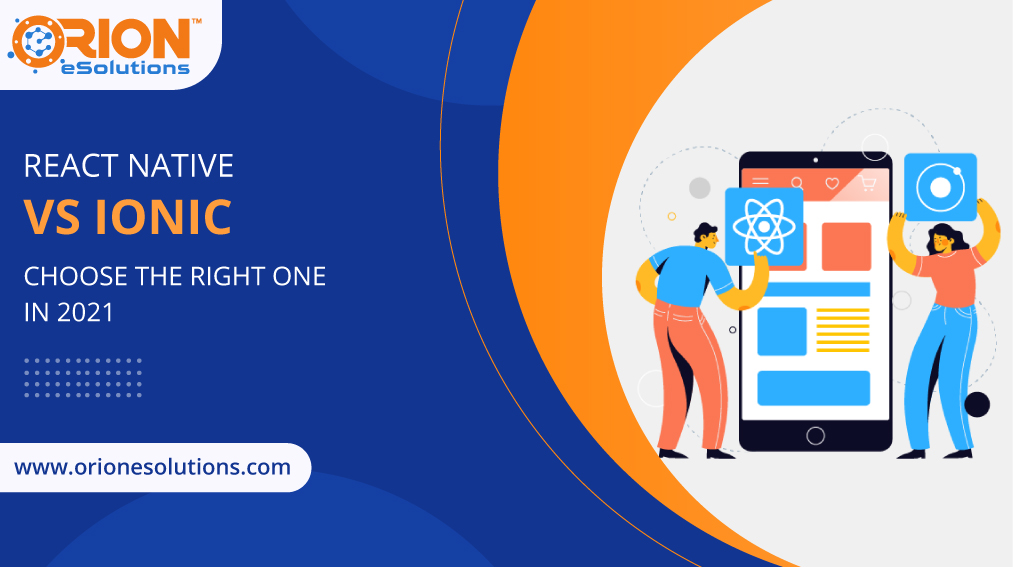The “hybrid vs native” question still lingers among programmers and coders. In 2021, the choice is between React Native and Ionic, the two biggest players in the mobile app development frameworks market. According to AppBrain,
- Ionic is the most used in app development at 3% while React Native is at 1.3%.
- Market share in terms of app installs show 4.05% for React Native and 0.27% for Ionic.
To understand this stat, let us look at the difference between a native app and a hybrid app.
NATIVE VS HYBRID
Native and hybrid apps differ in many ways including UX, performance, technology used, features, and associated costs.
-
Hybrid Mobile Apps
The underlying tech in hybrid apps are HTML, CSS, JavaScript and other web technologies. WebView is the platform that they all run on. Through native modules and plugins, they can be developed as Single Page Apps or Progressive Web Apps.
-
Native Mobile Apps
Platform specific UI components are needed to run native mobile apps. Java for Android and Objective-Cor Swift for iOS are used to build these apps. They cannot be reused between platforms and there are about no drawbacks to the efficiency of these apps.
Now, with a surface understanding of native and hybrid mobile apps, let us know a little bit about React Native and Ionic.
REACT NATIVE
React Native is a JavaScript based framework. It helps create native mobile apps and is supported by a huge community of developers. The corporate backing comes from Facebook. It uses the “learn once, write everywhere” principle. Facebook, Oculus, Coinbase, Shopify, Tableau, FlipKart, Discord, NerdWallet, Skype, Bloomnerg, Tesla, and Wix among many others use the React Native framework.
IONIC
With a shared codebase between mobile, web, and desktop apps, Ionic is a hybrid development framework for web apps. Ionic is rich in features and much more capable than web apps since it uses Cordova and PhoneGap to access native features. Ionic follows the “write once, use everywhere” principle. The Ionic framework has been used by MarketWatch, Pacifica, Sworkit, Diesel,StockPlan Connect, Honeyfi, McLaren, JustWatch, mcDonald’s, Untappd, Nationwide, and Cryptochange among a plethora of others. According to Ionic, over 5 Million apps have been created using its framework.
Now let us take a quick look at how the Ionic framework and the React Native framework compares against each other and determine the best one for 2021.
IONIC VS REACT
-
The Tech
React uses features that are native to the UI. This is what gives it the aesthetics of a native application. The native form also allows the developers to give a seamless experience to the end user.
Ionic uses web tech. This enables it to achieve multi-platform applications. It is based on Angular JS and uses the code base in a minimal fashion. Angular enables Ionic to have a smoother process and be extremely user-friendly.
-
Performance
React demands the developers to make platform-specific changes to achieve the most efficient components. React Native has a much more stable framework. This makes it efficient for large scale projects with higher budgets. The framework also enhances responsiveness and detailing of the UI.
On the other hand, Ionic’s hybrid approach makes it much more convenient for prototyping or facilitating an urgent requirement. Using CSS, JavaScript and HTML5 components, Ionic enables faster app development but the user might be asked to download additional plugins to enable the native features.
-
Coding
As discussed earlier, React uses the “learn once, write everywhere” logic. This framework will suggest suitable components that respect the native aesthetics, to the developers.
Contrary to that, Ionic can run the same code across all platforms. It adapts to the platform and learns its behavior in order to provide the native aesthetics.
Apart from these differences, React native has a community of 1752 contributors while Ionic has just 268. And in order to pinpoint the better one for 2021, we need to understand the benefits and drawbacks of both Ionic and React Native.
ADVANTAGES OF IONIC
- Open source
- Easy to learn
- Built in components
- Speed development cycle
- Familiar development environment
- Cordova and PhoneGap wrapping
DISADVANTAGES OF IONIC
- Requires WebView
- Apache Cordova required to access hardware functionality
- Slight performance issues
ADVANTAGES OF REACT NATIVE
- Stable and reliable for large scale projects
- Android, iOS and Windows app code reusability.
- Codes are not dependent on the platforms
- Vast community
DISADVANTAGES OF REACT NATIVE
- Require native development skills.
- Lack of custom modules
- Slight debugging and compatibility issues.
Now that we have laid down the facts and figures, let us conclude by determining if one is above the other.
SUMMING UP
The choice will be largely influenced by the type of project you are undertaking, the time of development, and the skills garnered by the team. According to a popularity survey by Ionic,
- 86% of web developers have used Ionic and 16% went for React Native.
- To build PWAs, 72% preferred Ionic while 21% picked React Native.
- On GitHub, Ionic has 41,000 stars and React Native has 89,100 stars.
These statistics boil down to the fact that it is not feasible to put one over the other objectively. We can conclude by understanding that if the requirement is a low budget, high performance app in a limited time, Ionic is the better one and if the requirement is a high budget, large scale app, React Native is the better one, for 2021. At Orion, we specialize and deliver excellence in both.









